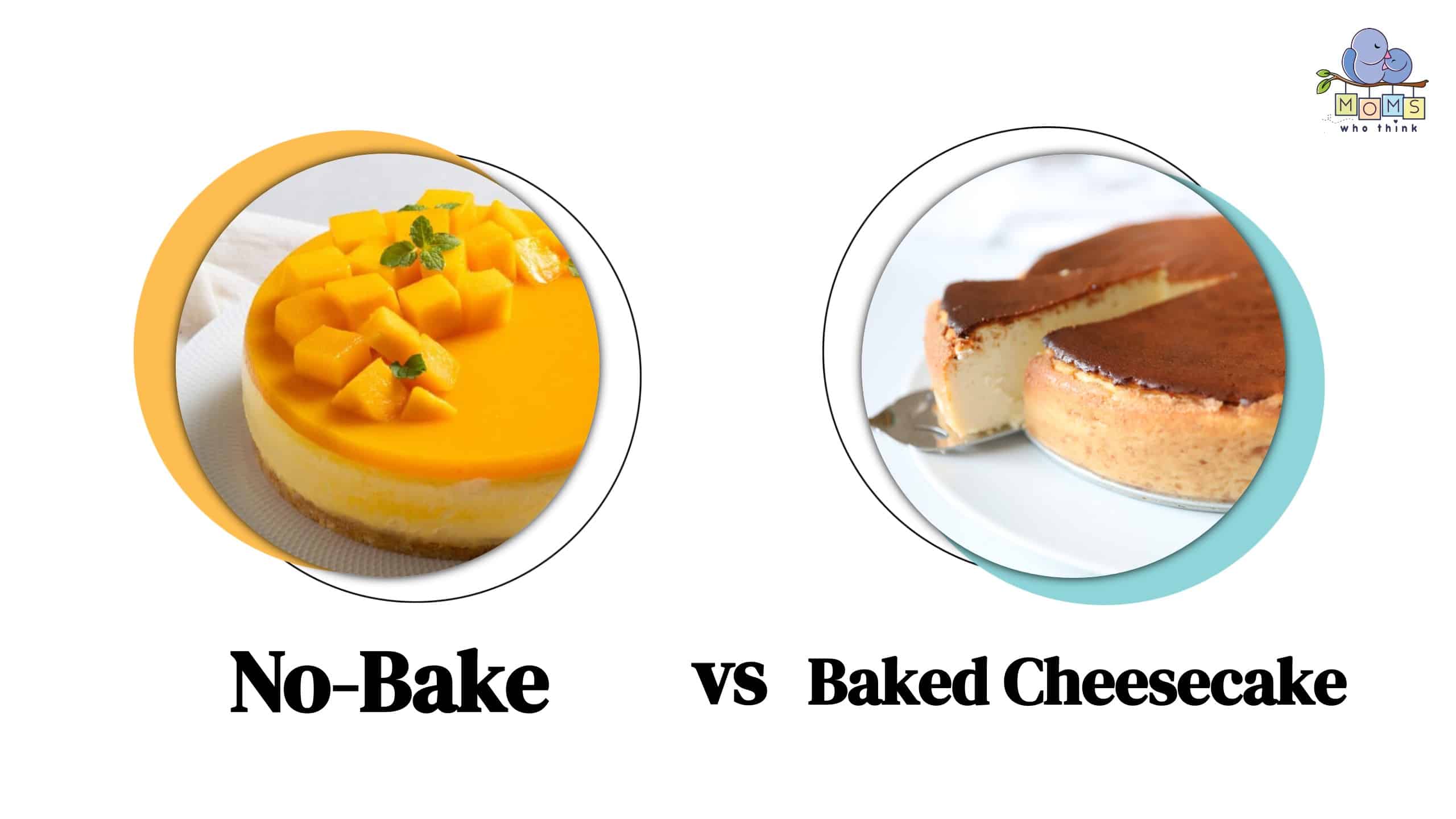Cheesecake is a delicious dessert eaten all around the world, there are two main types: no bake vs. baked cheesecake. No-bake cheesecake doesn’t contain any thickening ingredients or eggs and is set in the fridge. Baked cheesecake consists of a mixture of sugar, cheese, and eggs spread over cookie crumbs or graham crackers and then baked in the oven. The texture is dense, smooth, and velvety whereas a no-bake cheesecake is light and fluffy.
Although both cheesecakes are creamy there are key differences between the two which can impact the flavor, texture, and overall experience of enjoying this dessert. If you are looking for a quick and easy dessert, understanding the differences between no-bake and baked cheesecake can help you decide which type of cheesecake to make for your next occasion.
In this article, we'll explore the differences between no-bake and baked cheesecake, the ingredients, equipment required for the preparation, cooking methods, texture, flavor, and nutritional values of each type.
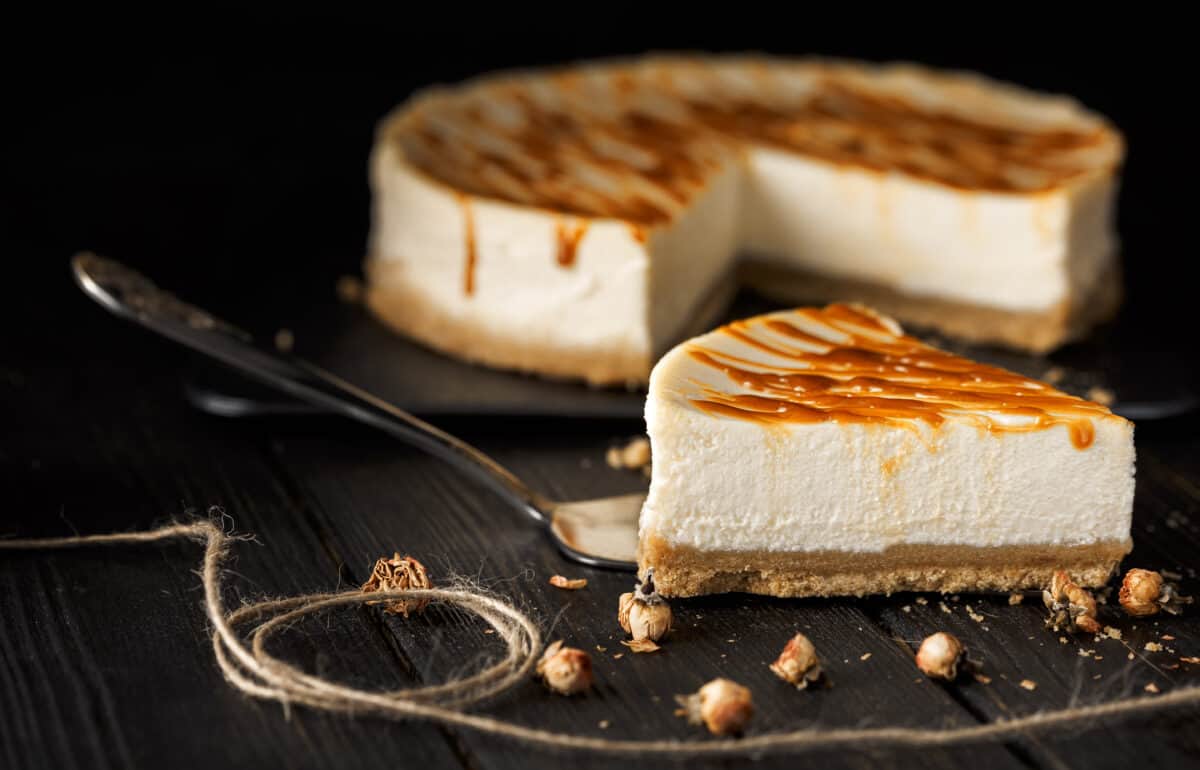
For summer entertaining, cheesecake is the ideal dessert.
©Bystrov/Shutterstock.com
No-Bake vs. Baked Cheesecake: What is the Difference?
The primary difference between no-bake and baked cheesecake is that no-bake cheesecake is chilled to firm up while baked cheesecake is cooked in an oven. Earlier we noted that no-bake cheesecake has different ingredients that include cream cheese, sugar, and other ingredients such as sour cream, heavy cream, and vanilla while baked cheesecake is made with cream cheese, eggs, sugar, and flour.
The ingredient and preparation differences lead to different flavors. No-bake cheesecake has a light, mousse-like texture, and a creamy, sweet flavor while baked cheesecake has a denser, creamier texture. The eggs in it give it a rich, custard-like flavor.
Finally, no-bake cheesecake is quicker to prepare while baked cheesecake requires more preparation. If you're baking a cheesecake, it usually benefits from being made a day in advance to allow the flavors to meld.
For best results, the cake should be cooled completely before slicing. Baked cheesecake can be served as-is, but toppings are also popular, such as fresh fruit, almonds, or shaved chocolate. Alternatively, serve it with your favorite fruit sauce such as raspberry, blueberry, or lemon curd. No matter how you serve it, baked cheesecake is a delicious, classic dessert that will please everyone.
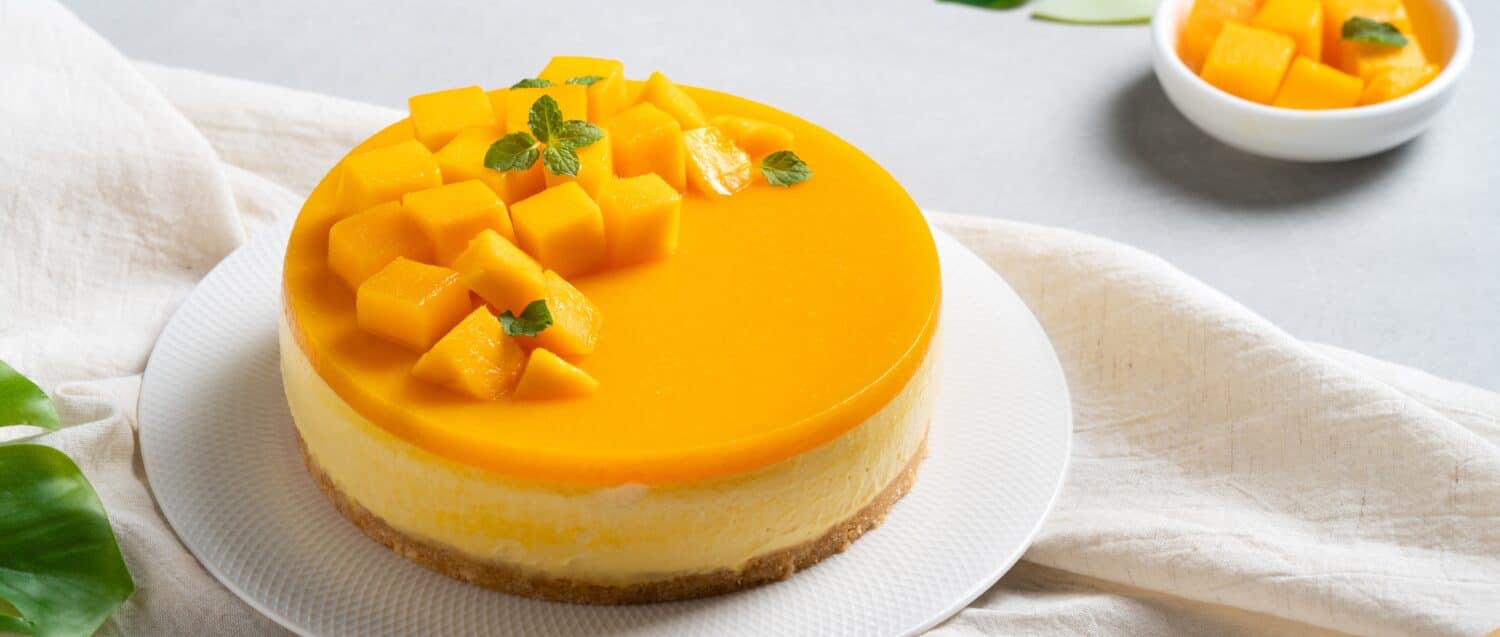
Mango glazed no-bake cheesecake is perfect for those summer occasions.
©YamisHandmade/Shutterstock.com
Where did Cheesecake Originate?
The exact origin is not known, but it is believed to have originated in Ancient Greece. According to food historians, cheesecake was served to athletes during the first Olympic Games in 776 BC. It was also served to the winners of sporting events in Ancient Rome. Cheesecake was also famous throughout the Middle Ages in Europe, although the ingredients and recipes varied in the late 1800s, cream cheese was invented and quickly became the main ingredient in modern cheesecakes. This cheesecake style became popular in the 1920s and is the basis for the cheesecakes we enjoy today.
Ingredients and Equipment Required for Both Cheesecakes
The ingredients for no-bake cheesecake are simple and easy to find. You will need cream cheese, heavy cream, sugar, vanilla extract, and a graham cracker crust. For a baked cheesecake you will need sour cream, sugar, eggs, cream cheese, vanilla extract, and your choice of crumbs for the crust. Although both will require a mixing bowl, an electric mixer, a rubber spatula, and a pie dish or spring form pan you will also need a water bath for a baked cheesecake. The ideal baked cheesecake recipe involves using a water bath, sometimes called a bain Marie. As a result, the cheesecake cooks evenly and maintains its creamy texture throughout the oven. It also controls the heat so that the edges of the pan don't cook faster than the center.
Preparing No-Bake Cheesecake
To make no-bake cheesecake, you will first need to prepare your graham cracker crust. Mix together the crust ingredients and press them into the bottom of your pie dish or springform pan. When preparing the filling, beat together cream cheese, sugar, and vanilla extract until smooth. In a separate bowl, whip heavy cream until it forms stiff peaks. Fold the whipped cream into the cream cheese mixture, then pour the mixture over the crust. Chill the cheesecake in the fridge for at least 4 hours or overnight.
Preparing Baked Cheesecake
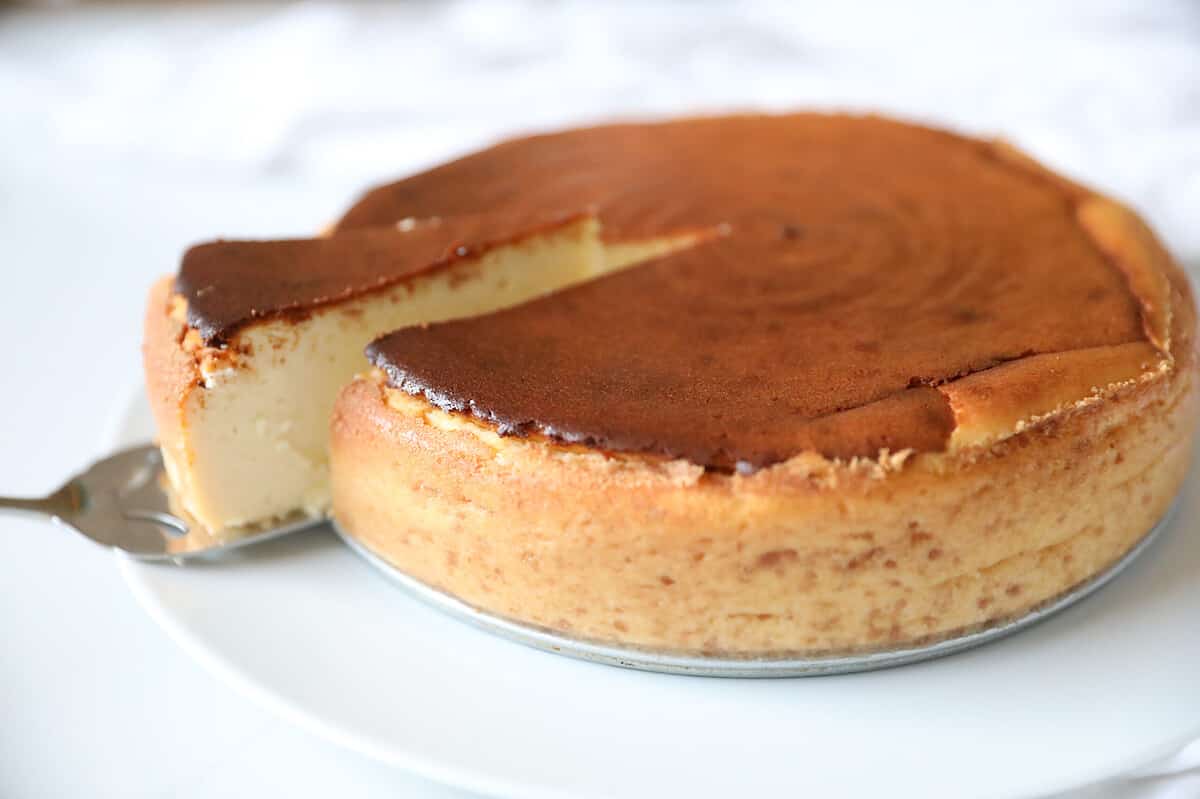
Cutting into a baked cheesecake
©rontav/Shutterstock.com
For baked cheesecake first, preheat your oven to 325°F then, prepare your crust mix with your choice of cracker crumbs and melted butter. Next, press the mixture into the bottom of a pan. In a separate bowl, beat cream cheese, sugar, and vanilla extract until smooth. Add in sour cream and eggs, one at a time, and mix until well combined. Pour the filling over the crust and bake in a water bath for about 1 hour. Allow the cheesecake to cool before serving it.
Nutritional Values of No-Bake vs. Baked Cheesecake: Calories, Fat, Cholesterol, and More
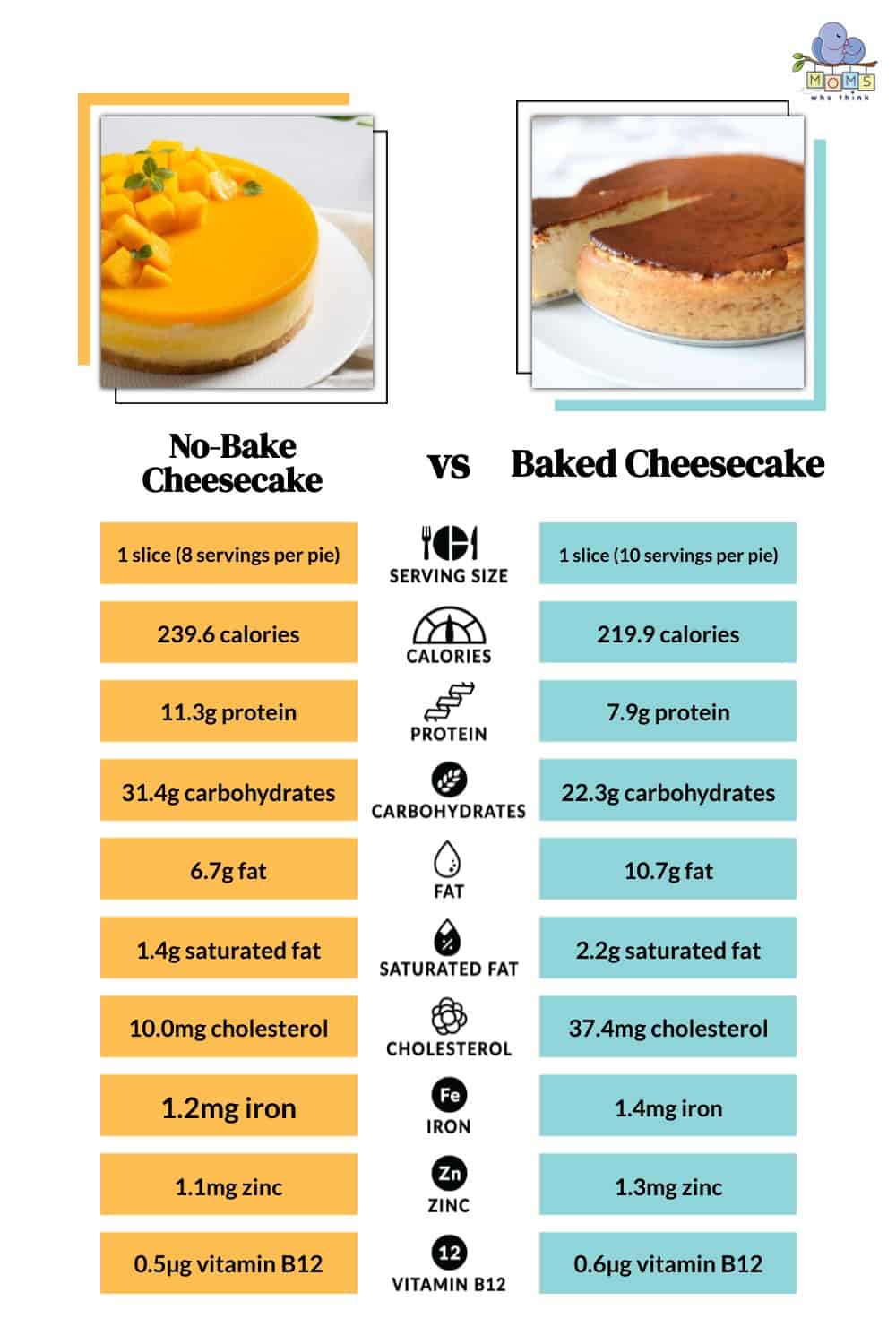
A comparison of baked and no-bake cheesecake
©
In the chart below we will compare the nutritional values of no-bake vs. baked cheesecake in more detail. Because of the addition of eggs, baked cheesecake has higher cholesterol, fat, and saturated fats. No-bake cheesecakes have a higher density of carbohydrates and sugar. Keep in mind that these nutrition facts will change with toppings and recipes that call for varying ingredients.
| No-Bake Cheesecake Serving Per Recipe: 8 Serving Size: 1 serving | Baked Cheesecake Serving Per Recipe: 10 Serving Size: 1 serving | |
|---|---|---|
| Calories | 239.6 | 219.9 |
| Total Fat | 6.7g | 10.7g |
| Saturated Fat | 1.4g | 2.2g |
| Polyunsaturated Fat | 1.9g | 3.6g |
| Monounsaturated Fat | 3.0g | 1.1g |
| Cholesterol | 10.0mg | 37.4mg |
| Sodium | 495.6mg | 120.3mg |
| Potassium | 91.1mg | 32.8mg |
| Total Carbohydrate | 31.4g | 22.3g |
| Dietary Fiber | 1.3g | 0.4g |
| Sugars | 19.7g | 8.4g |
| Protein | 11.3g | 7.9g |
When it comes to nutritional value, both types of cheesecake can be high in fat and sugar. However, no-bake cheesecake tends to have less fat, making it a slightly healthier option.
Final Conclusion
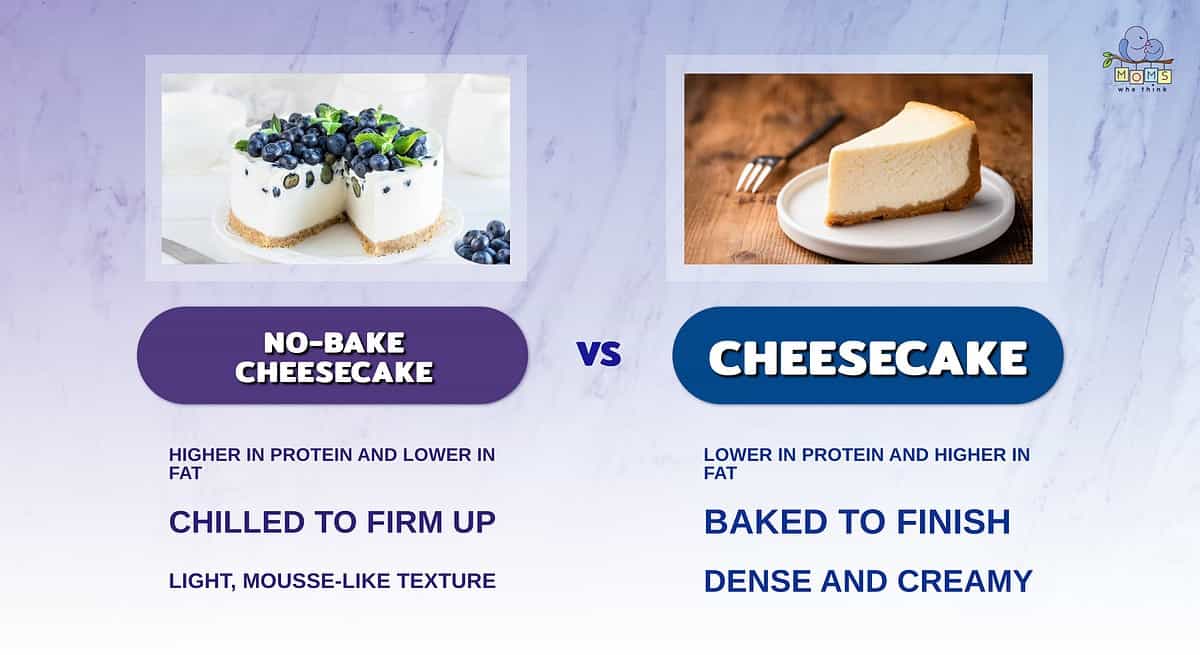
- No-bake cheesecake's higher protein and lower fat content have caused some to label it as a healthy alternative to regular cheesecake. No-bake cheesecake is healthier than regular cheesecake, but it shouldn't be mistaken for a healthy dessert.
- One of the biggest differences between these two cheesecake types is that one is chilled to firm it up, while the other is baked. No-bake cheesecake is great to make on hot days when you don't want to turn the oven on.
- Some people love regular cheesecake for its delicious creaminess and density, while others find it sits too heavy on their stomach. If you fall into the latter category, no-bake cheesecake might be for you.
Ultimately, the choice between no-bake and baked cheesecake comes down to your personal preference and the occasion. If you're short on time or looking for a lighter dessert option, no-bake cheesecake is a great choice. But if you want to impress guests or have a special occasion coming up, baked cheesecake is the way to go. In conclusion, whether you prefer the simplicity of no-bake cheesecake or the depth of flavor and texture of baked cheesecake, both are delicious desserts that can be enjoyed by anyone. By understanding the differences between the two, you can make an informed decision about which type of cheesecake to make for your next gathering.
Frequently Asked Questions
Can I use the same ingredients for both no-bake and baked cheesecake?
Yes and no. While many of the ingredients for both no-bake and baked cheesecake are the same, there are some differences. For example, no-bake cheesecake often uses whipped cream or cool whip for a lighter, fluffier texture. In contrast, baked cheesecake typically requires eggs, sour cream, or heavy cream for a creamier, denser texture. It's always best to follow a recipe specific to the type of cheesecake you're making.
No-bake vs. cheesecake can you freeze them?
Yes, both types can be frozen. No-bake cheesecake can be frozen for up to a month, and baked cheesecake can be stored in the freezer for up to three months. To freeze, wrap it tightly in plastic wrap or aluminum foil and place it in an airtight container. For best results first thaw it in the refrigerator overnight before serving.
Is there a difference in taste between no-bake and baked cheesecake?
Yes, there is a difference in taste between the two types of cheesecake. No-bake cheesecake is typically lighter and creamier in texture, with a more mousse-like consistency. Baked cheesecake, on the other hand, is denser and creamier, with a firmer, cake-like texture. The flavors of the two types of cheesecake can also differ, with baked cheesecake often having a more pronounced tangy flavor due to the addition of sour cream or lemon juice.
Should my cheesecake be brown on top?
To prevent your cheesecake from getting cracks and over-browning on top it is best to bake it in a water bath. This method of baking helps to keep the cheesecake moist, creating a creamy and delicate texture. The even distribution of heat that a water bath provides also prevents the cheesecake from cracking, ensuring that it looks as good as it tastes.
The options for creating a perfect cheesecake are endless. Why not try making a no-bake or baked cheesecake today and enjoy this classic dessert in all its glory?
Print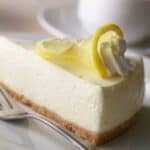
No Bake Cheesecake
Ingredients
1 graham cracker crust
2 8-ounce packages cream cheese, softened
1/4 cup white sugar
1 teaspoon pure vanilla extract
1 cup heavy whipping cream
Instructions
1. Beat the cream cheese until smooth, then slowly add the sugar and vanilla. Beat mixture until well blended.
2. In a clean chilled bowl, beat the whipping cream until soft peaks form.
3. Slowly beat the whipped cream into the cream cheese mixture.
4. Spoon the filling mixture into the graham cracker crust. Chill for 4-6 hours before serving.
